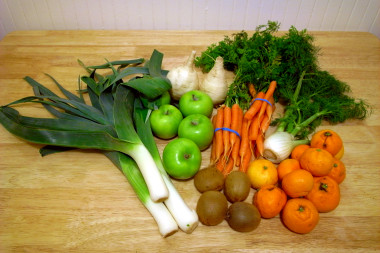Cookies in the cupboard

I like to eat, I like to cook, and I like to blog about the both.

Got some left over meat you want to do something with? Make a Hachis Parmentier! Yeah, you have no idea how to pronounce that, and neither did I even after hearing it over and over again (in French). Here’s a helpful pronunciation gloss: HA-she PAR-mon-tee-ay.
Basically it’s what the English-speaking world calls shepherd’s pie. Ground up leftover meat and vegetables (carrots in particular) on the bottom, mashed potatoes on top, optionally topped off with a healthy layer of shredded cheese. Or at least this is how Stephanie likes it, and it’s similar to how her sister made it for us in France.
I’ve wanted to tweak the recipe a bit, reducing the potato to meat ratio to about 3:2, and adding a few bonus ingredients. Tonight I had my chance. I finely chopped up some leftover “burgundy-seasoned” lamb tips (that were crazy good by the way, you can find them at Trader Joe’s) along with some homemade meatballs we had in the freezer. Then I browned them together in a little bacon fat and olive oil. To this I added a lot of shredded carrots and a bunch of peas.
This went on the bottom of a long baking dish which I dusted with some herbes de provence, and then I topped with little dollops of goat cheese (chèvre) here and there. Meanwhile I’d been steaming some skinned and large diced russet potatoes, which I mashed with a half cup of melted butter and about a half cup of whole milk and a teaspoon of salt. I gently spread the mashed potatoes on top of the goat cheese, meat, and veggies, and then topped it all off with some grated parmesan. Oh yeah, it got some little bits of butter on top too.
After 30 minutes at 400 degrees, here’s how it came out:
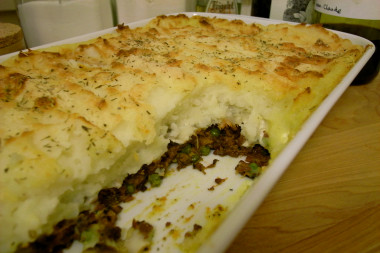
I’ve been wanting to make a lasagna using homemade pasta sheets for a while now. Out of the blue I had the idea of replacing the traditional tomato meat sauce with a chunky mushroom sauce. Thus a culinary adventure was born!
This gave me and Stephanie a mission at the farmer’s market yesterday—we needed mushrooms, and lots of them. We picked up about a pound of portobellos, a good pound of brown mushrooms, and half a pound of shittakes. I sliced the portobellos and shittakes and started them sauteeing in a healthy bit of butter and olive oil. I held off on the brown mushrooms because my 3.5qt saute pan was already overflowing.
I rinsed and quartered the brown mushrooms and then threw them in, keeping everything lubricated with olive oil, and seasoning the “ragout” with sea salt, fresh ground pepper, and some finely ground herbes de provence we’d “imported” from France. From that point on I kept things moist with a splash of Cabernet Sauvignon now and then—I think I used about a half bottle by the end. Just before we put together the lasagna, I finished the sauce with about a pint of cream.
Tony Bull came over (he’d missed the ravioli party, so this was the next best thing) and helped us get the pasta made. Stephanie had already whipped up a batch of dough, and so they began making lasagna sheets. They’d roll out one quarter of the dough at a time, which was enough for one layer of pasta when cut in half. Meanwhile I whipped together some of the best ricotta I’ve ever seen (from Cowgirl Creamery) with two eggs, grated parmesan and salt, pepper, and herbes de provence.
Then we began the assembly. First a little bit of sauce and a splash of cream to give the bottom layer of pasta some moisture. This we followed with fresh pasta sheets, a layer of the ricotta mixture, the mushroom cream sauce, and shredded mozzarella and grated parmesan. And repeat. We filled the pan and went through all our ingredients after three layers.
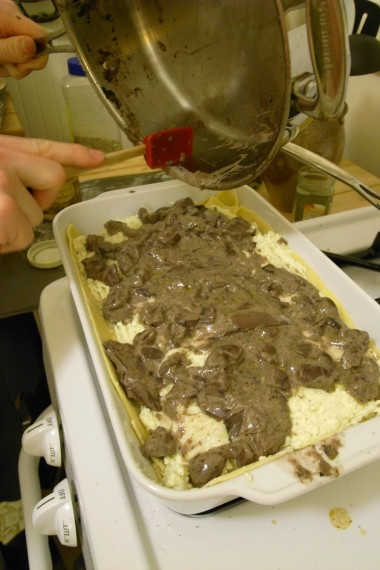

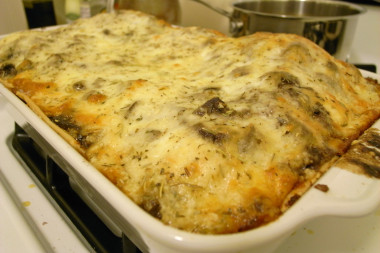
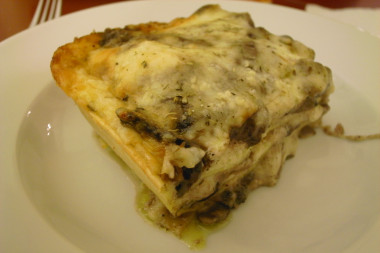
How did it turn out? I don’t even think there are words. But the mouth feel of the homemade pasta sheets was just stunning. At the time, I could only compare it to ham, in terms of texture. It wasn’t noodley or rubbery, but it had this heartiness unlike any lasagna I’ve ever had. And the edges were perfectly done. And every bite held together. And the cheese was a perfect complement to the mushrooms. I’ve got to go heat up the leftovers!
It’s what was for dinner.

Featuring two vegetables from the biweekly delivery: leeks and turnips. The “poivre” (or pepper) sauce was made from a combination of butter, shallots, flambeed brandy, red wine, beef stock, dijon mustard, and heavy cream. Yum-my!
Awhile ago I wrote that one of my favorite things about the city was joining a community-supported agriculture co-op. Ironically just after I wrote that, Stephanie left the job where the vegetables were delivered. Though there were a few other locations downtown where we could have elected to pick them up, extending our trek home after commuting from Sausalito was a little too much to bear. That and it was getting to be a bit of a chore to always choose the fruits or vegetables we wanted each week. So we let our winter “subscription” expire without renewing.
Then this past September I stumbled upon the idea of having fresh fruits and nuts delivered to work with another CSA called Farm Fresh to You (by Capay Organic). Every other week we got a great assortment of fruits and nuts which I shared with the office, all of which would disappear in about 3 days. Around Thanksgiving the tech group at FM moved across the street to a new space, and it didn’t make sense to me to continue the fruits and nuts delivery for just a few of us—sharing them with everyone was half the fun. So I decided to switch my biweekly order to a small box of vegetables and fruits to bring home for me and Stephanie. Unlike the first CSA, with Farm Fresh to You we no longer got to choose what we wanted in advance. I’m sure that makes it a lot easier for them to prepare, and for us it’s one less thing to remember to do.
Plus the best thing is it forces us to be creative and find a recipes for some vegetables we’d probably never pick up at the supermarket, let alone identify, like fennel, rapini, or turnips. There’s something about the lack of choice in this situation that’s actually freeing. The first CSA we’d joined was called “Eat with the Seasons” and though I understood what that meant conceptually, I really had no idea what that meant in practice. Growing up in a world with cold storage and a global supermarket meant I had practically no working knowledge of seasonal growing patterns. I had access to almost anything all the time. So by eating more seasonally and by subscribing to a regular delivery schedule, not only do I feel freer, I’m also guaranteed never to be bored. Every other week comes with a slightly different assortment, bringing with it new cooking challenges.
Here’s what we discovered in our box this week:
